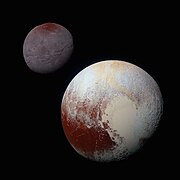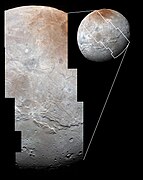Kharon (bulan)
 Kharon dalam warna hampir benar, keterangan ditingkatkan[note 1] | |
| Penemuan | |
|---|---|
| Ditemui oleh | James W. Christy |
| Tarikh penemuan | 22 Jun 1978 |
| Designasi | |
| Sebutan | Inggeris: /ˈʃærən/ SHARR-ən atau /ˈkɛərən/ KAIR-ən[note 2] |
| Dinamakan sempena | Kharon |
| Nama alternatif | (134340) Pluto I[1] |
| Ciri-ciri orbit | |
| Epok 2452600.5 (2002 Nov 22) | |
| Paksi semimajor | 19591km[2] |
| Kesipian | 0.0002[2] |
| Tempoh orbit | 6.3872304±0.0000011 h (6 d, 9 h, 17 m, 36.7 ± 0.1 s) |
| Kelajuan purata orbit | 0.21 km/s[note 3] |
| Kecondongan | 0.080° (hingga khatulistiwa Pluto)[2] 119.591°±0.014° (hingga orbit Pluto) 112.783°±0.014° (hingga ekliptik) |
| Longitud nod menaik | 223.046°±0.014° (hingga ekuinoks musim bunga) |
| Satelit bagi | Pluto |
| Ciri-ciri fizikal | |
| Min jejari | 606.0±0.5 km[3][4] (0.095 Bumi, 0.51 Pluto) |
| Perataan | <0.5% [5] |
| Luas permukaan | 4.×106 km2 (0.0090 Bumi) |
| Isi padu | (9.32±0.14)×108 km3 (0.00086 Bumi) |
| Jisim | (1.586±0.015)×1021 kg[3][4] (2.66×10−4 Bumi) (12.2% daripada Pluto) |
| Min ketumpatan | 1.702±0.017 g/cm3[4] |
| Graviti permukaan khatulistiwa | 0.288 m/s2 |
| Halaju lepas | 0.59 km/s 0.37 bt./s |
| Tempoh putaran | segerak |
| Albedo | 0.2 hingga 0.5 di sudut fasa suria 15° |
| Magnitud ketara | 16.8[6] |
| Magnitud mutlak (H) | 1[7] |
| Diameter sudut | 55 mili-lengkuk sek[8] |
| |
sunting | |
Kharon (Charon), juga dikenali sebagai (134340) Pluto I, ialah bulan yang terbesar daripada lima satelit semula jadi diketahui planet kerdil Pluto. Bulan ini ditemui pada tahun 1978 di Balai Cerap Tentera Laut Amerika Syarikat, Washington, D.C., menggunakan plat fotograf diambil di Stesen Tiang Bendera Balai Cerap Tentera Laut Amerika Syarikat (NOFS).
Dengan separuh diameter dan satu perlapan jisim Pluto, Kharon ialah bulan yang amat besar berbanding jasad induknya. Pengaruh gravitinya sebegitu rupa sehingga barycenter sistem Pluto–Kharon terletak di luar Pluto.
The reddish-brown cap di kutub utara Kharon mengandungi tholin; makromolekul organic yang boleh jadi ramuan penting kehidupan. Tholin ini dihasilkan daripada from metana, nitrogen dan gas berkaitan dibebaskan dari atmosfera Pluto dan berpindah melebihi 19,000 km (12,000 bt) ke bulan yang mengelilingi orbit.[9]
Kapal angkasa lepas New Horizons merupakan satu-satunya prob yang telah melawat sistem Pluto. Kapal angkasa lepas berkenaan menghampiri Kharon dalam 27,000 km (17,000 bt) pada tahun 2015.
Galeri
[sunting | sunting sumber]-
Peta global Kharon
-
Pemandangan warna tertingkat proses sama Pluto dan Kharon
-
Mozek warna tertingkat peleraian tinggi Kharon
-
Pluto dan Kharon, berdasarkan skala. Dilihat oleh New Horizons on approach.
-
Pluto dan Kharon seperti dilihat oleh New Horizons
(warna; 11 Julai 2015). -
Pluto dan Kharon seperti dilihat oleh New Horizons
(warna palsu; 13 Julai 2015). -
Kharon – bahagian malam seperti dilihat oleh New Horizons
(17 Julai 2015).
Video
[sunting | sunting sumber](dikeluarkan pada 1 Oktober 2015).
See also
[sunting | sunting sumber]Nota
[sunting | sunting sumber]Rujukan
[sunting | sunting sumber]- ^ Jennifer Blue (2009-11-09). "Gazetteer of Planetary Nomenclature". IAU Working Group for Planetary System Nomenclature (WGPSN). Dicapai pada 2010-02-24.
- ^ a b c "Planetary Satellite Mean Orbital Parameters — Satellites of Pluto". Solar System Dynamics. NASA's Jet Propulsion Laboratory. 2013-08-23. Dicapai pada 2017-12-27.
- ^ a b Stern, S.A.; Bagenal, F.; Ennico, K.; Gladstone, G.R.; Grundy, W.M.; McKinnon, W.B.; Moore, J.M.; Olkin, C.B.; Spencer, J.R. (16 Oct 2015). "The Pluto system: Initial results from its exploration by New Horizons". Science. 350 (6258): aad1815. arXiv:1510.07704. Bibcode:2015Sci...350.1815S. doi:10.1126/science.aad1815. PMID 26472913.
- ^ a b c Stern, S.A.; Grundy, W.; McKinnon, W.B.; Weaver, H.A.; Young, L.A. (15 Dec 2017). "The Pluto System After New Horizons". Annual Reviews of Astronomy ans Astrophysics. 2018. arXiv:1712.05669.
- ^ Nimmo, F.; Umurhan, O.; Lisse, C.M.; Bierson, C.J.; Lauer, T.R.; Buie, M.W.; Throop, H.B.; Kammer, J.A.; Roberts, J.H.; McKinnon, W.B.; Zangari, A.M.; Moore, J.M.; Stern, S.A.; Young, L.A.; Weaver, H.A.; Olkin, C.B.; Ennico, K.; and the New Horizons GGI team (1 May 2017). "Mean radius and shape of Pluto and Charon from New Horizons images". Icarus. 287: 12–29. arXiv:1603.00821. Bibcode:2017Icar..287...12N. doi:10.1016/j.icarus.2016.06.027.
- ^ "Classic Satellites of the Solar System". Observatorio ARVAL. April 15, 2007. Dicapai pada 2007-10-19.
- ^ David Jewitt (June 2008). "The 1000 km Scale KBOs". Institute for Astronomy (UH). Dicapai pada 2008-06-13.
- ^ "Measuring the Size of a Small, Frost World" (Siaran akhbar). European Southern Observatory. 2006-01-04. Diarkibkan daripada yang asal pada 2006-01-18. Dicapai pada 2007-10-19.
- ^ Bromwich, Jonah Engel; St. Fleur, Nicholas (14 September 2016). "Why Pluto's Moon Charon Wears a Red Cap". New York Times. Dicapai pada 2016-09-14.
<ref> dengan nama "Buie_2006" yang ditentukan dalam <references> tidak digunakan dalam teks sebelumnya.Pautan luar
[sunting | sunting sumber]| Wikimedia Commons mempunyai media berkaitan Kharon (bulan) |
- Charon Profile Diarkibkan 2014-10-08 di Wayback Machine at NASA's Solar System Exploration site
- Christy, J. W; Harrington, R. S (1978). "The satellite of Pluto". Astronomical Journal. 83: 1005. Bibcode:1978AJ.....83.1005C. doi:10.1086/112284.
- Hubble reveals new map of Pluto, BBC News, September 12, 2005
- Person, M. J; Elliot, J. L; Gulbis, A. A. S; Pasachoff, J. M; Babcock, B. A; Souza, S. P; Gangestad, J (2006). "Charon's radius and density from the combined data sets of the 2005 July 11 occultation". The Astronomical Journal. 132 (4): 1575–1580. arXiv:astro-ph/0602082. doi:10.1086/507330.
- Cryovolcanism on Charon and other Kuiper Belt Objects
- New Horizons Camera Spots Pluto’s Largest Moon – July 10, 2013 Diarkibkan 2013-12-08 di Wayback Machine
- New Horizons in the PHSF clean room at KSC, Nov 4, 2005[pautan mati kekal]
- NASA CGI video of Charon flyover (14 July 2017)
- CGI video simulation of rotating Charon by Seán Doran (see album for more)
- Google Charon 3D, interactive map of the moon
- "2016 Lunar & Planetary Science Conference by National Institute of Aerospace".
Templat:Pluto Templat:Moons of dwarf planets
Bulan dalam Sistem Suria | ||
|---|---|---|
| Bulan planet |  | |
| Sistem bulan yang lain | ||
| Bulan terbesar | ||
Templat:Trans-Neptunian objects navbox Templat:Dwarf planets
Text is available under the CC BY-SA 4.0 license; additional terms may apply.
Images, videos and audio are available under their respective licenses.








